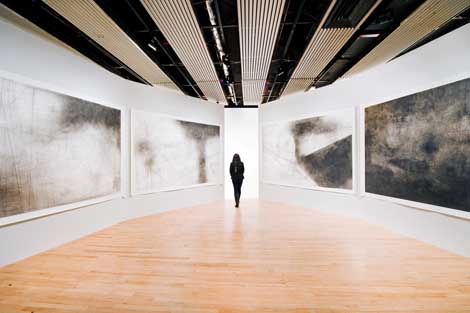London is one of the world’s leading centers for contemporary art and also has a history that reaches back beyond Roman times. It’s a place of contradictions, home to great financial and cultural institutions, fine universities and wonderful buildings, as well as to a range of diverse ethnic communities that rub shoulders with the privileged rich. Fragmented, loud, glittering, unknowable and dark in equal measure, like Calvino’s Invisible Cities, London presents itself as a series of interlocking dreams. So it was with a sense of anticipation that I visited the Hayward’s exhibition hoping for some reflection of this complex utopian/dystopian palimpsest. How would 23 different artists explore how digital and actual space meld and crossover in this ancient city? What would they reveal about the effects on our everyday lives?
The first work encountered on entering the gallery is Lindsay Seer’s Nowhere Less Now. Screened inside the upturned hull of a fabricated ship her video touches on her seafaring background, interwoven with the narrative of a fictional seaman. More stage set than artwork the effect is unnecessarily overblown, which is really how one might describe the whole exhibition. A baggy, over-curated smorgasbord of a show, coherence is heavily dependent on the copious wall texts that strain to link art that in other circumstances might not actually be linked at all. It’s hard to see what Ursula Mayer’s film about a transgender model, shown alongside an array of glass dildos and cabinets that includes tributes to Ayn Rand and Margaret Thatcher, has in common with the work of last year’s Turner Prize winner, Laure Prouvost’s The Artist, where a series of signs announce “Keep Left” or “Don’t Look Up.”
Fracture and collage seem to be the hallmarks of this show as in Tim Etchell’s wall of fly-posted headlines that create fictional scenarios such as “Delirium Tremens Orchestra Play New Songs by Silvio Berlusconi and Dmitry Medvedev” and Susan Hiller’s audio collage of disembodied voices describing extra-terrestrial phenomena. While John Stezaker’s uncanny and witty photographic creations, welded together from old film stills, marry the dissonance of surrealism with postmodernist fragmentation.
Lloyd Corporation sounds like the name of a multinational business but is, in fact, the nomenclature of the art duo Ali Eisa and Sebastian Lloyd Rees whose work claims to focus on the fall-out from the corporate world. Their practice includes sculpture, installation and video, though for this show they have devised a performance entitled The World for Less, which takes place each Saturday at different locations around the Hayward and features actors performing as street vendors.
Amongst this collection of very disparate work is Emma McNally’s intense and beautiful Choral Fields 1-6 (2014) in graphite on paper. The title suggests both music and a field of vision or activity. Inventing new ways of using graphite and carbon, which she erases with sandpaper, she creates drawings that allude to space and the microscope, to navigational charts and the stars, in work that is both tense and gestural, muscular yet lyrical.
A special newspaper Mirror City has been edited by the novelist Tom McCarthy and written by the artists to accompany the show. Presumably rather tongue-in-cheek—it suggests that the sport coverage can be found on page 42 when, in fact, the paper only consists of 23 pages. Though reading it doesn’t—and perhaps is not meant to—clarify anything about what we are seeing. Walking through this exhibition veers between the stimulating, annoying, mystifying and pretentious, the whole edifice being over dependent on a hypothesis that’s not really borne out by the whole. Like a fairground hall of mirrors there are numerous distortions of “reality.” The implication seems to be that the city is a series of chimeras. That’s an interesting and valid position but one not really supported by this sprawling rather forced show.
Hayward Gallery, Southbank Centre, London SE1 8XX
www.southbankcenter.co.uk


